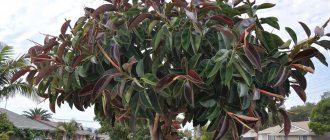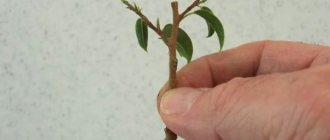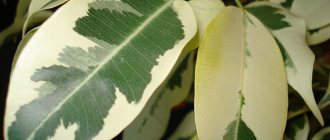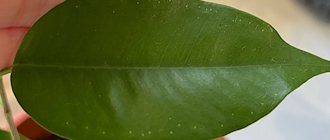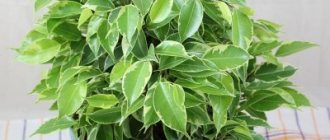Description of rubber ficus
The rubber ficus (Ficus elastica) is a true giant in nature. The height of the trunk reaches 30 meters. At home, the plant has a more modest size. Rich green oval foliage is covered with gloss. There is a noticeable point at the top. When young, the leaves are covered with a reddish stipule, which falls off when the plate unfolds.
Ficus flowering at home cannot be seen, since in an apartment it is impossible to create the same conditions for the development of culture as in the natural environment. Flowering can only be observed in greenhouses.
Bloom
Ficus blooms extremely rarely . Blooming flowers - syconia - do not have a decorative appearance. They are inconspicuous, resemble peas and are formed when pollinated by insects. The resulting fruits reach 1 cm in diameter and resemble figs in appearance. However, eating them is prohibited.
The appearance of flowers takes a lot of energy from the plant. A small tree may die, devoting all its energy to forming buds. Therefore, if syconia form, it is recommended to cut them off.
Varieties of ficus rubber
There are many plant varieties:
- Variety Exotic. An unpretentious variety with rich green leaves, which are attached to the trunk by thin petioles. Can be grown in partial shade.
- Variety Danielle. Easy to care for, leaves are 6 cm long.
- Variety Monique. Light green foliage is shaded with gold. The leaves are small, reaching 6 cm in length. Brown stripes radiate from the central vein. With age, the variegation dissolves, the plates become monochromatic.
- Variety Reginald. A characteristic feature is the variegated color of the leaves. Young specimens have light green leaves. Ragged spots are scattered across the surface.
- Variety Kinkye. Bush-like form, formed by a large number of thin shoots. A cream stripe runs down the center of the green, elastic foliage.
- Variety Nicole. Characterized by moderate growth. Erect shoots are decorated with small leaves, 4 cm long. The leaf plates are concave along the central vein.
- Variety Stralight (Starlight). Picky about conditions of detention. If not properly cared for, the light leaves quickly fall off.
- Barok variety. A variegated variety with interesting, curled foliage. Easy to care for, but grows very slowly.
Sometimes you can buy ficus Elastica mix at a flower shop. The set includes plants of different varieties.
Possible problems
| Problem name | Cause | Treatment |
| The leaves are falling | Drying up of the earth | Increase watering frequency, following recommendations |
| Insufficient lighting | Install a phytolamp or move the plant to a more illuminated place | |
| Sudden temperature change | Adjust the temperature background | |
| Leaves turn yellow | Excess nutrients | Rinse the substrate with 3 times the volume of water |
| Excess salts | Transplant the plant into a new substrate | |
| Excessively large pot volume | Transplant the bush into a smaller pot | |
| Root rotting | Remove rotten areas and transfer the bush to a new substrate | |
| Lack of growth | Nutrient deficiencies | Apply fertilizer according to the diagram |
| Filling the pot with roots | Transplant the plant into a larger pot |
Yellowing of leaves
Growing ficus rubber
The main feature of ficus when grown at home is its unpretentiousness.
Lighting
Ficus Elastica is demanding of light, so it is advisable to place the pot with the plant next to a south window, but not on the windowsill, since direct rays of the sun will cause burns on the foliage.
Attention! When grown in partial shade, growth will be noticeably reduced. It is possible that the loss of the lower tier of foliage cannot be ruled out.
Temperature
In spring and summer, it is advisable to maintain the temperature in the room at +21-24°C. In winter, it is recommended to lower the temperature, but do not allow it to fall below +15°C.
What kind of pot do you need?
Ficus rubber does not like to grow in a spacious pot. The less space, the faster the flower grows.
What kind of soil/soil is needed?
Young plants are replanted annually. Older specimens do not require frequent transshipment, but the top layer of soil will need to be changed every year.
It is preferable to choose a substrate that is nutritious, well permeable to air and moisture. The earth is mixed with crushed coal and sand. The amount of baking powder is 1/5 of the total volume of the nutrient mixture.
First steps after purchase
Transportation of the purchased bush should be carried out carefully , avoiding injury to the trunk and leaves. After purchase, you should inspect the root system of the plant. If the entire volume of the pot is filled with roots, the young plant needs to be transplanted into a larger container. If the purchased specimen feels free, the transplant should be left until next year.
The plant should be installed in a suitable location:
- No drafts.
- Avoid direct sunlight.
Failure to follow the recommendations leads to a decrease in growth and resistance of the bush to pathogens.
Caring for ficus rubber at home
Caring for a plant with glossy foliage involves providing timely watering, fertilizing, and spraying the foliage to increase humidity.
How often to water
Watering throughout the growing season should be moderate. In summer, the plant is watered at the root 2 times a week, in winter – once a week.
Spraying
Ficus rubber needs foliage spraying. To increase air humidity, you can place the pot with the plant on a tray filled with wet pebbles. In addition, the foliage should be wiped with a wet cloth.
Feeding and fertilizer
Starting in April, when the plant enters the active growth phase, the ficus is fed 2 times a month. Organic and mineral fertilizers are used. It is advisable to alternate them.
On a note! To make the leaves look glossy and reflect the surface, gardeners advise wiping the plates with non-alcoholic beer.
Trimming
Formative pruning will help curb the wild growth of ficus. In addition, the procedure will give the plant a compact appearance. Thanks to pruning, the number of shoots and foliage will increase, which is important, since with age the flower “goes bald”, that is, it loses its lower foliage.
Throughout the year, it is recommended to carry out sanitary pruning, in which thin shoots that are damaged and growing inward are removed.
Many gardeners practice removing the top. The maximum that such a procedure can lead to is the formation of another bud at the top. To get a good effect, it is recommended to remove up to 4 internodes.
Is it possible to leave without care while on vacation?
The answer is clear - no. Not a single plant can live without water. At a minimum, you need to find someone who will water the ficus during your absence.
Humidity
In summer, daily spraying is carried out from a spray bottle. Once every 2-3 weeks, the leaf blades are cleaned of dust and dirt with a damp sponge.
Elastica responds well to a warm shower, while the soil in the pot is covered with film. In winter, they usually limit themselves to wiping the leaves.
Reproduction of rubber ficus
Ficus elastica can be propagated by cuttings, layering and seeds.
Cuttings
The most convenient way with 100% results. You should choose a healthy cutting (stem or apical) and make a cut at an angle. The height of the cutting is at least 13-14 cm. All foliage will have to be removed, leaving only two plates at the very top.
The cutting is left at room temperature so that the milky juice stops flowing. You can root in water or directly in the ground. The last option is more effective. To make the ficus take root faster, it is recommended to create a mini-greenhouse over the cuttings.
Single-color varieties of ficus root without problems, varieties with variegated foliage are a little more difficult, so it is recommended to treat the cuttings with a root formation stimulator before planting.
By layering
Plants with painted foliage are easier to root by layering. To obtain layering, you will need to make a cut in the stem and insert a match into it. At the cut site, the stem is wrapped in sphagnum moss, and a film is rolled over it. As soon as roots appear on the cut, the cutting can be disconnected from the mother specimen and transplanted into a new pot.
Seeds
Small ficus seeds are laid out on the surface of moist, slightly compacted nutrient soil. To get seedlings, the seeds need to create comfortable conditions. To increase temperature and humidity, cover the container with seeds with film. The first shoots will appear after 1.5-2 months. Care consists of providing young plants with good lighting and regular watering.
Ways to reproduce
Propagation by cuttings. Small stems are cut off obliquely, the foliage is removed from each, and placed under an open tap. Then they place it in a filled glass, covered with a transparent bag, and wait for the results.
Air layering. A cut is cut in the main stem to a depth equal to one third of its thickness, fixed with a match, and wrapped in sphagnum (moss) and polyethylene. The moss is periodically moistened while waiting for germination.
Reproduction of elastica by leaves is nothing more than a myth. A leaf may sprout, but nothing further will happen; it will not germinate fully.
Diseases and pests
Among the harmful insects that plague the rubber ficus, scale insects and spider mites can settle on the shoots. If malicious pests are detected, the plant is treated with an infusion of tobacco and laundry soap. If it is possible to take the flower pot outside, treatment with acaricides is recommended.
When growing ficus, you may encounter some problems. If the ficus loses its foliage, the reason may be due to overdrying/overmoistening of the earthen clod, lack of lighting, or the presence of drafts.
The foliage turns yellow as a result of a lack of nutrients in the soil. To eradicate the problem, it is advisable to feed the plant with complex fertilizer.
Stunting is another problem that many gardeners face. There are three reasons:
- nutritional deficiencies;
- constraint of space;
- lack of natural light.
When errors in maintenance are corrected, the ficus actively begins to grow.
Causes of diseases
It happens that pests and diseases attack. Sometimes spider mites and scale insects manifest themselves.
To save the situation, use a damp towel to wash the trunk and branches with a tobacco-soap solution, and after a few hours with clean water. If the degree of damage is high, treat the bush with an insecticide.
If you neglect to care for the tree, you can provoke its diseases.
It happens that young gardeners wonder what to do if the ficus sheds its leaves. Losing your lower ones is a normal process.
But if they fly around everything, you need to look for where you overlooked:
- The nutrient medium was overdried or flooded
- Draft or temperature fluctuations
- Standing in a dark place
If the crown turns yellow and falls off, start from the previous point. But there may be other prerequisites:
- Excessive fertilization.
- Excess salts.
- Too large flowerpot
- Root rotting
- Doesn't get enough light.
If you are wondering why your pet is not growing, the answer lies in the following:
- Sun deficiency
- Not enough vitamins
- The shoots are too crowded
Photo of rubber ficus in the interior
Ficus Elastica fits perfectly into any interior. Beautiful glossy foliage looks decorative all year round.
Growing rubber ficus at home requires certain skills and sufficient space, as the flower grows up to 2 m in height. With proper formation, you can get a chic compact bush that will be the pride of the family.
Trimming
Pruning is necessary to curb the growth of the bush and increase the number of leaves. To obtain lateral branches, 5-6 internodes from the top of the plant. It is recommended to shorten an excessively elongated plant. The cut cuttings can be rooted and planted in the same container.
Pruning should be done in early spring before the buds awaken. Otherwise, only the uppermost growth bud is activated. You need to make cuts with a sharp blade, protecting your hands with gloves. The released juice must be removed with running water.
Transfer
It is not necessary to replant the ficus after purchase if the pot corresponds to the required size. Young specimens need replanting every year. If the flower is very mature and replanting can be disastrous for it, then it is recommended to simply replace the top layer of soil. The right time is April-May. The main sign that it is time to replant a flower is depletion of the soil. If during watering water immediately passes through the drainage holes, then such a substrate must be changed. The pot for transplanting should be 3-6 cm larger than the previous one.


